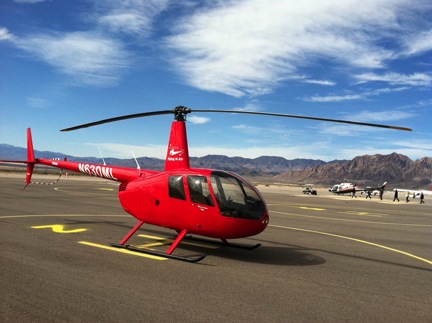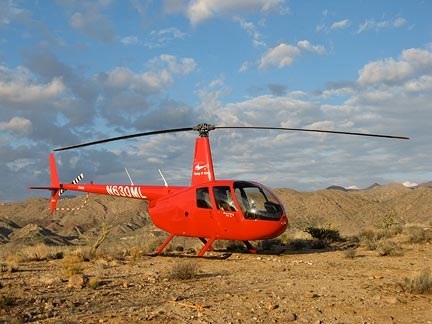I finally realize that the key to success in my business is good clients with good jobs.

N630ML at Boulder City, NV during a recent charter flight.
I’ve owned my helicopter charter business since October 2001, when I started it with a commercial pilot certificate and a Robinson R22 Beta II helicopter. In 2005, I got serious: I upgraded to a Robinson R44 Raven II and got a Single Pilot Part 135 certificate from the FAA. So I count January 2005, when I took delivery of the helicopter, as my serious start date.
But it was just this past week that I had an epiphany about my business and the key to its success.
Let me tell you about it.
My Original Strategy
Since day one of my business — even in the R22 days — my goal was to maximize flight time, with the idea that it would also maximize revenue time. This caused me to do several things that were really not in the best interest of my company:
- Appeal to the lowest common denominator. I assumed that one way to maximize flight time was to make flights cheap enough for most folks to afford something. In the beginning, I actually offered 15 minute flights. Trouble is, it takes just as much time to preflight and postflight the aircraft for a 15-minute flight as a 2-hour flight. So I would spend two hours of my day to get 1/4 hour of revenue. (What was I thinking?) Later, I upped the shortest flight to 30 minutes.
- Offer rides at outdoor events. This is part of the lowest common denominator concept, but in this case, I offered a bunch of short rides — usually 8-10 minutes each — during one or two day events. When things were good, I’d do great. We had lots of really good events. When things were not good, however, I’d lose money, sometimes spectacularly. I recall our Lake Havasu Spring Break disaster, which cost about $2K in setup, fees, and repositioning time for a total of 9 rides. I pulled the plug after just two days. (To this day I harbor bitter feelings about the little shit kids on spring break, interested solely in beer and boobs.)
- Make “special deals” on pricing. I cannot tell you how many clients attempt to weasel down my pricing by telling me about their budget. Photographers and real estate people are notorious for this. For years, I’d “work with them” to keep my prices low, just to get their business.
- Donate flights to charities in exchange for free advertising. Let’s face it, who really looks at sponsors in the booklets at those charity events? The last straw was when I discovered that my company was not mentioned in a sponsor booklet at all.
- Spend money on ineffective advertising. I tried newspaper advertising, magazine advertising, tour guide advertising, and even foreign language tour guide advertising. I tried trifold brochures and rack cards in racks I had to pay to be placed in. I tried radio advertising. I tried Google Adwords and Facebook ads. Although I don’t have exact numbers, I am absolutely certain that I spent at least five times more than what I received in revenue through customers gained by these efforts. I didn’t even get that many calls. The few that mentioned the rack cards were either looking for a tour over the Grand Canyon (which I can’t do) or trying to buy a cheap (less than $50/person) helicopter ride.
- Work with hotel concierge staff. Part of a concierge’s job is to find things for their guests to do. Helicopter flights are a good option. There are four drawbacks to working with hotel concierge staff:
- No matter how much printed material you provide to describe your tours in detail, they never seem to understand what you can do. Evidently, once they file the 16-page, full-color Information Package I send them, they can’t be bothered to consult it.
- If you’re not in their face every week or so, they won’t remember you. I don’t have time to schmooze 20 different concierges all over the Phoenix/Scottsdale area every week.
- Staff changes; the person you schmoozed last week may have moved back to Minnesota this week, so now you’ll have to schmooze her replacement. Honestly, I can’t keep track of them all.
- They won’t even consider recommending you unless they get a good sized piece of the action. Like 20% off the top. My margins are so thin that if I paid that, they’d make more money than me.
I just had to add this side note because it really does apply. Groupon is perfect for businesses who want to sell a ton of products or services below their cost. (Why anyone would want to do that is beyond me.) Businesses justify the deep discounts that Groupon requires as an “advertising expense.” But it’s likely to be the most expensive and least effective means of advertising a business could try. Sure, you’ll get lots of customers, but will you ever see them again without a Groupon certificate in their hands? I wrote extensively about Groupon here and here.
The underlying goal of all of this was to get any work I could, just to have work. This is how I thought it should be. Seems to make sense, no?
Strategies Change
As I’ve already hinted, I began to get smart about my strategy as time went on.
- I stopped offering short, cheap flights. I now have a one-hour minimum for any flight.
- I stopped doing rides at events unless the event is within 30 minutes flight time of my base or guaranteed to draw a good-sized crowd of families.
- I no longer offer special deals. My price is my price. Take it or leave it.
- I no longer donate flights to any charity. (Hell, it’s cheaper to just write them a check.)
- I slashed my advertising budget. Now I rely on word of mouth, rack cards placed in free places, and a Web site that apparently Googles pretty well.
- I cut concierge commissions to 10% and, other than sending out the Concierge Package at the beginning of the season and answering their occasional calls, I don’t contact them at all.
You’d think that drastic changes like these would reduce the amount of business I get. It didn’t. In fact, I seem to get more calls and more conversions of those calls to real business.
Think Different
Still, the amount of business I got was barely enough to support my helicopter operation. I certainly couldn’t quit my “day job” as a writer. There’s a lot of competition in the Phoenix area, with at least three helicopter flight schools that have many aircraft and qualified pilots at their disposal. Clearly, I needed to set myself apart from them.
One way I did this was by offering day trips and multi-day excursions. This was something my competition was not willing to do — they simply couldn’t take a helicopter offline for a whole day or multiple days.
Another way I differentiated myself from others was to agree to fly as needed for any kind of mission I was permitted to do. You need me to chase a race car around a track 50-100 feet off the ground? I’ll do it. You need me to fly alongside a cliff face at 20 knots? I’ll do it. You need me to fly sideways low over a golf course from tee to green? I’ll do it. The flight schools won’t. That’s “dangerous” flying and they’re not willing (or able due to insurance limitations) to let their pilots fly like that.
Just being willing to say yes, was a great way to increase my business. Still, my overall strategy was to fly as much as possible for whoever hired me to fly. That mean focusing on the quantity of jobs and not on the quality.
My Epiphany

Nosecam image from one of my recent wildlife survey flights. The work is difficult and dangerous, requiring me to fly alongside cliff faces hundreds of feet off the desert floor.
And that brings us to this past week. I was hired by a client to do a four to five day wildlife survey. I’d flown for this client three times before, most recently in February. In each instance, it was a one-day job with some intense flying. But this year, the client hired me to fly multiple missions, some of which would last multiple days.
This week’s job lasted four days. It would have gone a fifth, but we worked our butts off to finish what could have been two days’ work in just one very long day. (I took off from my base before sunrise and returned after sunset.) In that four days, I flew 31.6 hours. That’s more than I normally fly in a month.
And guess what? I’ve got another three days for the same client company next week. And another one or two days in the beginning of April. And possibly another two or three days in May.
That got me thinking about how much revenue comes from a job like this. A very good amount.
And that got me thinking about similar jobs that bring in a good chunk of revenue from consistent sources, like my cherry drying work, which actually made my company profitable for the past two years in a row.
It also got me thinking about clients like this — repeat clients that call me out for jobs again and again. Like the aerial photography clients I work for at Lake Powell and the people they directly or indirectly send my way.
It got me thinking that although the work I do for these people is a hell of a lot more challenging than flying tours around Phoenix or taking a couple up to Sedona for the day, it’s this work that earns real money. The money to not only keep my company afloat, but the money to make it profitable.
And that got me wondering why I’m still chasing around the odd flying job, dealing with difficult one-time clients and their sometimes outrageous needs, and, in general, doing flying jobs I simply don’t want to do.
These thoughts, one after another, formed my epiphany: a business like mine thrives on the work it does for a handful of good clients. Rather than trying to attract and please one-time clients, I should be working harder to find the good repeat clients who appreciate what I can do for them and rely on me to get the job done.
Now if you’re a business person and have already reached this conclusion, please don’t think poorly of me. Maybe I’m a little dense. Maybe I just didn’t see the big picture until now. But now that I’ve seen it, I’m looking at my business model in a completely different way.
Flying M Air’s Arizona season ends in May. Next season will be very different.


 My R44, parked out in the desert at a rides event.
My R44, parked out in the desert at a rides event.
